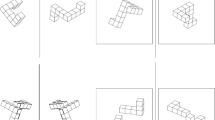Abstract
Mirror image-induced stimulation and the ability to use the mirror to improve navigational ability for the purpose of object location are considered measures of animal cognitive ability. The purpose of this study was to assess these cognitive abilities in sheep (Ovis aries) as part of a larger programme profiling the cognitive ability of this animal species. Three separate groups of sheep [(n = 29); 10 Welsh Mountain, 8 Norfolk Horned and 11 Borderdale] were trained (≥80 % criterion) to locate a salient object (yellow bucket containing cereal-based food) in one of two possible positions, from one of two possible starting points. Each group of sheep was then divided into two sub-groups. One sub-group was exposed to a mirror over a period of 15 days (mirror exposed), whilst the other group remained mirror naïve. All animals were then retested within the choice maze using the mirror, where two out of the possible four bucket positions were now ‘apparent’ (as reflections in the mirror), in order to assess whether mirror-exposed animals had a more accurate representation of the real bucket position. Sheep exhibited two out of the three archetypal stages of mirror-induced behaviour, namely social/exploratory and contingency behaviour, with differences existing between breeds. Welsh Mountain sheep spent significantly more time fixating on the self-image and touching the self-image with their muzzle than the other two breeds. During the test phase, no overall differences in performance were observed between the mirror-exposed and mirror-naïve groups. However, Welsh Mountain sheep did perform significantly more correct responses overall, compared to the other two breeds. Although the data did not convincingly demonstrate that sheep could use a reflective surface to improve their navigational ability, the observed differences between groups suggests that some breeds of sheep may demonstrate better navigational ability as well as having a greater engagement with the self-image than others.







Similar content being viewed by others
References
Amsterdam B (1972) Mirror self-image reactions before the age 2. Dev Psychobiol 5:297–305
Anderson JR (1986) Mirror-mediated finding of hidden food by monkeys (Macaca tonkeana and Macaca fascicularis). J Comp Psychol 100:237–242
Anderson JR, Gallup GG (2011) Do rhesus monkeys recognize themselves in mirrors? Am J Primatol 73:603–606
Bard KA, Todd BK, Bernier C, Love J, Leavens DA (2006) Self-awareness in human and chimpanzee infants: what is measured and what is meant by the mark and mirror test? Infancy 9:191–219
Boissy A, Aubert A, Desire L, Greiveldinger L, Delval E, Veissier I (2011) Cognitive sciences to relate ear postures to emotions in sheep. Anim Welfare 20(1):47–56
Broom DM, Sena H, Moynihan KL (2009) Pigs learn what a mirror image represents and use it to obtain information. Anim Behav 78:1037–1041
Gallup GG (1970) Chimpanzees: self-recognition. Science 167:86–87
Gieling ET, Mijdam E, van der Staay FJ, Bordquist RE (2014) Lack of mirror use by pigs to locate food. Appl Anim Behav Sci 154:22–30
Harding EJ, Paul ES, Mendl M (2004) Animal behavior: cognitive bias and affective state. Nature 427(6972):312
Itakura S (1987) Mirror guided behavior in Japanese monkeys (Muscata-Fuscata-fuscata). Primates 28:149–161
King AJ, Wilson AM, Wilshin SD, Lowe J, Haddadi H, Hailes S, Morton AJ (2012) Selfish-herd behaviour of sheep under threat. Curr Biol 22:R561–R562
Lawrence AB, Woodgush DGM (1988) Home-range behavior and social-organization of Scottish Blackface sheep. J Appl Ecol 25:25–40
Lynch JJ, Hinch GN, Adams DB (1992) The behaviour of sheep: biological principles and implications for production. C.A.B. International, Wallingford
Masson MEJ (2011) A tutorial on a practical Bayesian alternative to null-hypothesis significance testing. Behav Res Methods 43(3):679–690
Medina FS, Taylor AH, Hunt GR, Gray RD (2011) New Caledonian crows’ responses to mirrors. Anim Behav 82:981–993
Michelena P, Gautrais J, Gerard JF, Bon R, Deneubourg JL (2008) Social cohesion in groups of sheep: effect of activity level, sex composition and group size. Appl Anim Behav Sci 112:81–93
Michelena P, Sibbald AM, Erhard HW, McLeod JE (2009) Effects of group size and personality on social foraging: the distribution of sheep across patches. Behav Ecol 20:145–152
Morton AJ, Avanzo L (2011) Executive decision-making in the domestic sheep. PLoS ONE 6:e15752
Morton AJ, Howland DS (2013) Large animal models of Huntington’s disease. J Hunt Dis 2:3–12
Piggins D, Phillips CJC (1996) The eye of the domesticated sheep with implications for vision. Anim Sci 62:301–308
Plotnik JM, de Waal FBM, Moore D, Reiss D (2010) Self-recognition in the Asian elephant and future directions for cognitive research with elephants in zoological settings. Zoo Biol 29:179–191
Pokorna P, Hejcmanova P, Hejcman M, Pavlu V (2013) Activity time budget patterns of sheep and goats co-grazing on semi-natural species-rich dry grassland. Czech J Anim Sci 58:208–216
Povinelli DJ (1989) Failure to find self-recognition in Asian elephants (elephas-maximus) in contrast to their use of mirror cues to discover hidden food. J Comp Psychol 103:122–131
Prior H, Schwarz A, Guentuerkuen O (2008) Mirror-induced behavior in the magpie (Pica pica): evidence of self-recognition. PLoS Biol 6:1642–1650
Raftery AE (1995) Bayesian model selection in social research. Sociol Method 25:111–163
Reiss D, Marino L (2001) Mirror self-recognition in the bottlenose dolphin: a case of cognitive convergence. Proc Nat Acad Sci USA Stat Am 98:5937–5942
Zar JH (1996) Biostatistical analysis, 3rd edn. Prentice Hall, Upper Saddle River
Acknowledgments
We thank Calum Frost for his invaluable work training and testing the sheep. This work was funded by CHDI Inc.
Author information
Authors and Affiliations
Corresponding author
Rights and permissions
About this article
Cite this article
McBride, S.D., Perentos, N. & Morton, A.J. Understanding the concept of a reflective surface: Can sheep improve navigational ability through the use of a mirror?. Anim Cogn 18, 361–371 (2015). https://doi.org/10.1007/s10071-014-0807-3
Received:
Revised:
Accepted:
Published:
Issue Date:
DOI: https://doi.org/10.1007/s10071-014-0807-3




